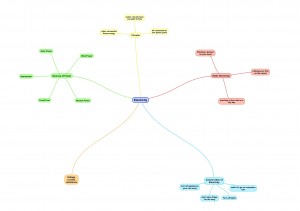Category: Science 9
Edible DNA Model
This is an edible model of a double helix. It is a double-stranded DNA molecule in which strands linked by hydrogen bonds form a spiral configuration.
Skype Chat with Tanya Harrison
 Tanya Harrison is a Planetary Scientist. She currently is studying features on Mars to tell us about climate change. Before though she worked with cameras on Mars rovers like Curiosity. She Skyped our class yesterday, December 9th 2015. We all took turns asking her a question and listening to her give us facts and information regarding our questions. I thought the experience was fun and cool way of learning instead of just reading a text book.
Tanya Harrison is a Planetary Scientist. She currently is studying features on Mars to tell us about climate change. Before though she worked with cameras on Mars rovers like Curiosity. She Skyped our class yesterday, December 9th 2015. We all took turns asking her a question and listening to her give us facts and information regarding our questions. I thought the experience was fun and cool way of learning instead of just reading a text book.
Our question was; “what is your favourite part of what you do?”
Another question asked was if she would consider space travel her answer was that due to being claustrophobic she didnt think that she could make it much farther than the earths orbit.
She also shared that it took NASA about 8-10 years to build a rover that would be able to be sent up to mars.
What we learned is that it does not take a day to create a rover it takes years just for the preperation. And the amount of work put into it for just a little bit of outcome. In conclusion this was very fun to do and provided us some education on the topic in a creative way.
Currents From the Kitchen
Currents From The Kitchen Lab

Results:
| orange | orange | negative voltage | No light bulb |
| orange | apple | 0.1 voltage | No light bulb |
| 2 oranges | apple | 0.2 voltage | No light bulb |
| pear | pear | 0.3 voltage | No light bulb |
| Apple | 2 pears | 0.4 voltage | No light bulb |
Observation:
To produce the best electron flow in our fruit\vegetables cell we used a series circuit. If your bulb won’t glow you can find out if electrons are flowing by connecting it to a voltmeter. The voltmeter measure the flow of the electrons. If you used the right vegetables they can create voltage but sadly not a lot. A light bulb takes a voltage of about 2 and fruits and vegetables create a voltage of 0.6 at the most. So no matter how many vegetables and fruits you put together it will never create enough voltage to power a light bulb. To improve our results I would modify the experiment by instead of asking to try and make the light bulb work I would give a list of fruits and vegetables and see which ones would have the greatest and least amount of voltage. The two metals in the fruits (copper and zinc) are causing the electrons to flow. The reason this works is because zinc is more reactive then copper. They may not be able to power light bulbs but they can create a small amount of voltage to create batteries. I don’t think this will be “the next big thing in clean energy” because it may create voltage but not enough. Even though it can create a battery it wouldn’t be able to produce much. With the amount of fruit and vegetables it takes to create the slightest bit of voltage it just wastes the material and time.
Sama and Alexis’ science predictions
We think that an orange will be the best. We think this because its very acidic kind of like a batterie. We dont think it will be very much of the reaction. It will probably only light the bulb a little.
Electricity Mind Map
1. What does resistance mean?
2. What is a current?
3. How is electricity made?
4. Whats the best way to make electricity?
5. Whats the worst way to make electricity?
6. How many electrons do you need to make electricity?
7. How does electricity flow?
Blog your learning-Investigating matter
Matter is a physical substance which has mass and volume. If you want to remember the states and there changes think water. Vapour is gas, water is liquid, and ice is solid. Now if you want to know how to change a solid into a liquid how would you turn a ice cube into water. You add heat; melting. If you want to change a solid into a gas how would you change an ice cube into vapour, by adding even more heat; sublimation. A gas into a solid or vapour into and ice cube you do the opposite, reversing sublimation; disposition. You have vapour and want to turn it into water, a gas to a liquid; condensation. Now you want to do the opposite turn a liquid into a gas you want evaporation. And finally a liquid into a solid, taking water and tuning it into an ice cube; Freezing. Kinetic molecular theory is the theory of how particles move. The movement can differ depending on the amount of energy coming from certain states. From the bag of change lab i learned that even the most basic day to day items can be mixed together and cause chemical changes. Some times chemical reactions cant just be seen but they can also be changed in a variety of different ways.



